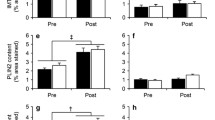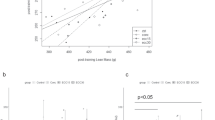Abstract
Fatty acid metabolism is influenced by training and diet with exercise training mediating this through activation of nuclear hormone receptor peroxisome proliferator-activated receptor α (PPARα) in skeletal muscle. This study investigated the effect of training and high fat or normal diet on PPARα expression in human skeletal muscle. Thirteen men trained one leg (T) four weeks (31.5 h in total), while the other leg (UT) served as control. During the 4 weeks six subjects consumed high fat (FAT) diet and seven subjects maintained a normal (CHO) diet. Biopsies were obtained from vastus lateralis muscle in both legs before and after training. After the biopsy, one-leg extension exercise was performed in random order with both legs 30 min at 95% of workload max. A training effect was evident as citrate synthase activity increased (P < 0.05) by 15% in the trained, but not the control leg in both groups. During exercise respiratory exchange ratio was lower in FAT (0.86 ± 0.01, 0.83 ± 0.01, mean ± SEM) than CHO (0.96 ± 0.02, 0.94 ± 0.03) and in UT than T legs, respectively. The PPARα protein (144 ± 44, 104 ± 28, 79 ± 15, 79 ± 14, % of pre level) and PPARα mRNA (69 ± [2, 2], 78 ± [7, 6], 92 ± [22, 18], 106 ± [21, 18], % of pre level, geometric mean ± SEM) expression remained unchanged by diet and training in FAT (UT, T) and CHO (UT, T), respectively. After the training and diet CS, HAD, PPARα, UCP2, UCP3 and mFABP mRNA content remained unchanged, whereas GLUT4 mRNA was lower in both groups and LDHA mRNA was lower (P < 0.05) only in FAT. In conclusion: 4 weeks one leg knee extensor training did not affect PPARα protein or mRNA expression. Furthermore, higher fat oxidation during exercise after fat rich diet was not accompanied by an increased PPARα protein or mRNA expression after 4 weeks.



Similar content being viewed by others
References
Andersen JL, Aagaard P (2000) Myosin heavy chain IIX overshoot in human skeletal muscle. Muscle Nerve 23:1095–1104
Andersen P, Adams RP, Sj¢gaard G, Thorboe A, Saltin B (1985) Dynamic knee extension as model for study of isolated exercising muscle in humans. J Appl Physiol 59:1647–1653
Bergström J (1962) Muscle electrolytes in man: determined by neutron activation analysis on needle biopsy specimens. A study on normal subjects, kidney patients and patients with chronic diarrhea. Scand J Clin Lab Invest Suppl 68:11–13
Betto DD, Zerbato E, Betto R (1986) Type 1, 2A, and 2B myosin heavy chain electrophoretic analysis of rat muscle fibers. Biochem Biophys Res Commun 138:981–987
Cameron-Smith D, Burke LM, Angus DJ, Tunstall RJ, Cox GR, Bonen A, Hawley JA, Hargreaves M (2003) A short-term, high-fat diet up-regulates lipid metabolism and gene expression in human skeletal muscle. Am J Clin Nutr 77:313–318
Chomczynski P, Sacchi N (1987) Single-step method of RNA isolation by acid guanidinium thiocyanate-phenol-chloroform extraction. Anal Biochem 162:156–159
Constantin-Teodosiu D, Cederblad G, Hultman E (1991) A sensitive radioisotopic assay of pyruvate dehydrogenase complex in human muscle tissue. Anal Biochem 198:347–351
Cresci S, Wright LD, Spratt JA, Briggs FN, Kelly DP (1996) Activation of a novel metabolic gene regulatory pathway by chronic stimulation of skeletal muscle. Am J Physiol 270:C1413–C1420
Fritz T, Kramer DK, Karlsson HK, Galuska D, Engfeldt P, Zierath JR, Krook A (2006) Low-intensity exercise increases skeletal muscle protein expression of PPARdelta and UCP3 in type 2 diabetic patients. Diabetes Metab Res Rev 22:492–498
Helge JW, Kiens B (1997) Muscle enzyme activity in man: role of substrate availability and training. Am J Physiol 272:R1620–R1624
Helge JW, Richter EA, Kiens B (1996) Interaction of training and diet on metabolism and endurance during exercise in man. J Physiol (Lond) 292:293–306
Higginson J, Wackerhage H, Woods N, Schjerling P, Ratkevicius A, Grunnet N, Quistorff B (2002) Blockades of mitogen-activated protein kinase and calcineurin both change fibre-type markers in skeletal muscle culture. Pflugers Arch 445:437–443
Horowitz JF, Leone TC, Feng W, Kelly DP, Klein S (2000) Effect of endurance training on lipid metabolism in women: a potential role for PPARalpha in the metabolic response to training. Am J Physiol Endocrinol 279:348–355
Ingelbrecht IL, Mandelbaum CI, Mirkov TE (1998) Highly sensitive northern hybridization using a rapid protocol for downward alkaline blotting of RNA. Biotechniques 25:420–426
Jonsdottir I, Schjerling P, Ostrowski K, Asp S, Richter EA, Pedersen BK (2000) Muscle contractions induces interleukin-6 mRNA production in rat skeletal muscles. J Physiol (Lond) 528:157–163
Jump DB, Clarke SD, Thelen A, Liimatta M, Ren B, Badin MV (1997) Dietary fat, genes, and human health. Adv Exp Med Biol 422:167–176
Kannisto K, Chibalin A, Glinghammar B, Zierath JR, Hamsten A, Ehrenborg E (2006) Differential expression of peroxisomal proliferator activated receptors alpha and delta in skeletal muscle in response to changes in diet and exercise. Int J Mol Med 17:45–52
Kersten S, Seydoux J, Peters JM, Gonzalez FJ, Desvergne B, Wahli W (1999) Peroxisome proliferator-activated receptor alpha mediates the adaptive response to fasting. J Clin Invest 103:1489–1498
Kiens B, Essen-Gustavsson B, Christensen NJ, Saltin B (1993) Skeletal muscle substrate utilization during submaximal exercise in man: effect of endurance training. J Physiol (Lond) 469:459–478
Kliewer SA, Sundseth SS, Jones SA, Brown PJ, Wisely GB, Koble CS, Devchand P, Wahli W, Willson TM, Lenhard JM, Lehmann JM (1997) Fatty acids and eicosanoids regulate gene expression through direct interactions with peroxisome proliferator-activated receptors alpha and gamma. Proc Natl Acad Sci USA 94:4318–4323
Leblanc PJ, Howarth KR, Gibala MJ, Heigenhauser GJ (2004) Effects of 7 wk of endurance training on human skeletal muscle metabolism during submaximal exercise. J Appl Physiol 97:2148–2153
Leone TC, Weinheimer CJ, Kelly DP (1999) A critical role for the peroxisome proliferator-activated receptor alpha (PPARalpha) in the cellular fasting response: the PPARalpha-null mouse as a model of fatty acid oxidation disorders. Proc Natl Acad Sci USA 96:7473–7478
Lin J, Handschin C, Spiegelman BM (2005) Metabolic control through the PGC-1 family of transcription coactivators. Cell Metab 1:361–370
Lowry OH, Passonneau JV (1972) A flexible system of enzymatic analysis. Academic, New York
Mahoney DJ, Parise G, Melov S, Safdar A, Tarnopolsky MA (2005) Analysis of global mRNA expression in human skeletal muscle during recovery from endurance exercise. FASEB J 19:1498–1500
McAinch AJ, Lee JS, Bruce CR, Tunstall RJ, Hawley JA, Cameron-Smith D (2003) Dietary regulation of fat oxidative gene expression in different skeletal muscle fiber types. Obes Res 11:1471–1479
Minnich A, Tian N, Byan L, Bilder G (2001) A potent PPAR{alpha} agonist stimulates mitochondrial fatty acid {beta}-oxidation in liver and skeletal muscle. Am J Physiol Endocrinol 280:E270–E279
Muoio DM, Way JM, Tanner CJ, Winegar DA, Kliewer SA, Houmard JA, Kraus WE, Dohm GL (2002) Peroxisome proliferator-activated receptor-{alpha} regulates fatty acid utilization in primary human skeletal muscle cells. Diabetes 51:901–909
Peters SJ, Harris RA, Wu P, Pehleman TL, Heigenhauser GJ, Spriet LL (2001) Human skeletal muscle PDH kinase activity and isoform expression during a 3-day high-fat/low-carbohydrate diet. Am J Physiol Endocrinol 281:E1151–E1158
Pilegaard H, Saltin B, Neufer PD (2003) Effect of short-term fasting and refeeding on transcriptional regulation of metabolic genes in human skeletal muscle. Diabetes 52:657–662
Pilegaard H, Saltin B, Neufer PD (2003) Exercise induces transient transcriptional activation of the PGC-1alpha gene in human skeletal muscle. J Physiol 546:851–858
Pilegaard H, Osada T, Andersen LT, Helge JW, Saltin B, Neufer PD (2005) Substrate availability and transcriptional regulation of metabolic genes in human skeletal muscle during recovery from exercise. Metabolism 54:1048–1055
Putman CT, Spriet LL, Hultman E, Lindinger MI, Lands LC, McKelvie RS, Cederblad G, Jones NL, Heigenhauser GJF (1993) Pyruvate dehydrogenase activity and acetyl group accumulation during exercise after different diets. Am J Physiol 265:E752–E760
Radegran G, Blomstrand E, Saltin B (1999) Peak muscle perfusion and oxygen uptake in humans: importance of precise estimates of muscle mass. J Appl Physiol 87:2375–2380
Russell AP, Feilchenfeldt J, Schreiber S, Praz M, Crettenand A, Gobelet C, Meier CA, Bell DR, Kralli A, Giacobino JP, Deriaz O (2003) Endurance training in humans leads to fiber type-specific increases in levels of peroxisome proliferator-activated receptor-gamma coactivator-1 and peroxisome proliferator-activated receptor-alpha in skeletal muscle. Diabetes 52:2874–2881
Saltin B, Gollnick P (1983) Skeletal muscle adaptability: significance for metabolism and performance. In: Peachey LD (ed) Handbook of physiology-skeletal muscle. American Physiological Society, pp 555–631
Siri WE (1961) Body composition from fluid spaces and density: analysis of methods. In: Brozek J, Henschel A (eds) Techniques for measuring body composition, National Academy of Sciences, Washington, pp 223–224
Tunstall RJ, Mehan KA, Wadley GD, Collier GR, Bonen A, Hargreaves M, Cameron-Smith D (2002) Exercise training increases lipid metabolism gene expression in human skeletal muscle. Am J Physiol Endocrinol Metab 283:E66–E72
Watt MJ, Southgate RJ, Holmes AG, Febbraio MA (2004) Suppression of plasma free fatty acids upregulates peroxisome proliferator-activated receptor (PPAR) alpha and delta and PPAR coactivator 1alpha in human skeletal muscle, but not lipid regulatory genes. J Mol Endocrinol 33:533–544
Acknowledgments
Erik A. Richter is thanked for performing the muscle biopsies. The skilled technical assistance of Irene Bech Nielsen, Jan Arvidsen and Jonas Treebak is acknowledged. The study was supported by grants from The Ministry of Culture Committee on Sports Research J.nr. N2000-10-033), Team Danmark Research funding and the Danish National Research Foundation (#504-14).
Author information
Authors and Affiliations
Corresponding author
Rights and permissions
About this article
Cite this article
Helge, J.W., Bentley, D., Schjerling, P. et al. Four weeks one-leg training and high fat diet does not alter PPARα protein or mRNA expression in human skeletal muscle. Eur J Appl Physiol 101, 105–114 (2007). https://doi.org/10.1007/s00421-007-0479-7
Accepted:
Published:
Issue Date:
DOI: https://doi.org/10.1007/s00421-007-0479-7




